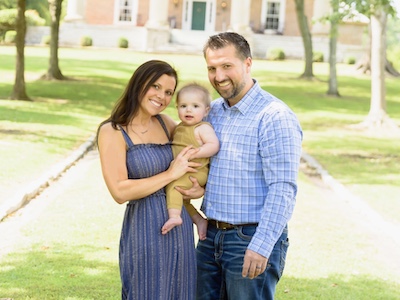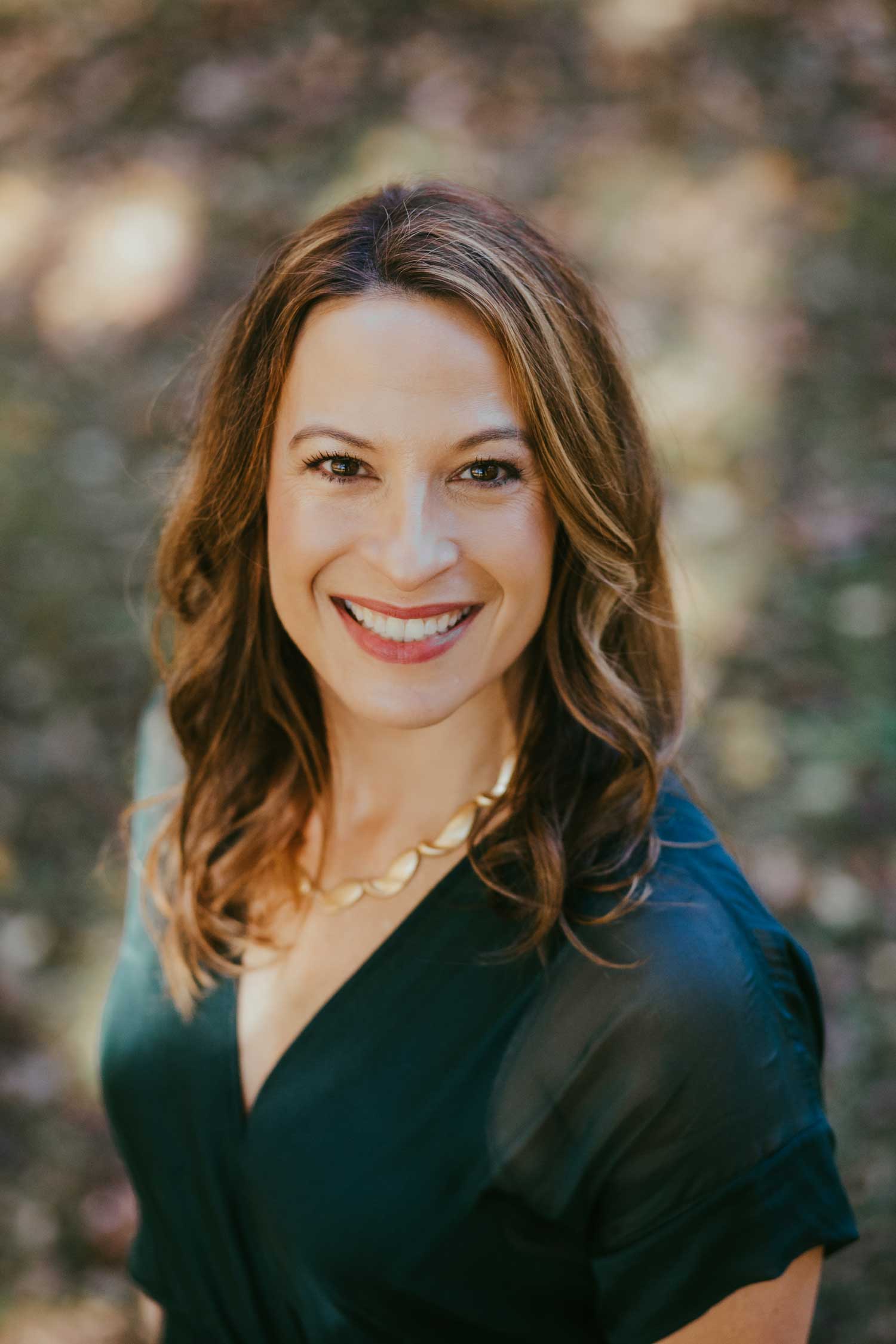This article was originally published on November 18th, 2020 and was updated in November of 2025 with a note from Dr. Scotchie at the end of the story.
Keeping their faith in God’s plan and an open mind when a low sperm count from varicocele and other factors drove their fertility destiny
“We were that couple that said we would never do IVF if it came down to our only option,” says Chrissie, a TRM patient and mom.
But when getting pregnant didn’t come easily after a year and a half of trying naturally, Chrissie and her husband, Jared, opened their minds to investigating options. “We said to each other, Well, let’s just see what all of this is about.”

Her OB-GYN referred her to Tennessee Reproductive Medicine, where she saw Dr. Jessica Scotchie. “Jared and I knew there was science behind infertility treatments, but we didn’t want to mess with God’s plan,” Chrissie says.
“But when we spoke to Dr. Scotchie, we realized there is more to it – it’s not just something controlled in a dish. There are other factors at play, and that changed our hearts. We wanted to do whatever we could to have a baby.”
Little did they know that several other factors would launch them on a four-year fertility journey of hope, sadness, joy and finally, a baby boy.
Chronic illness and a varicocele found by infertility testing played roles beyond their control
The first step was for Dr. Scotchie to perform a medical history and physical exam on Chrissie. She presented with a pre-existing condition called ulcerative colitis in which ulcers in the large intestine cause inflammation, nausea and dehydration.
“Dr. Scotchie really went above and beyond,” Chrissie notes, recalling how Dr. Scotchie called her gastroenterologist to explore how the condition and associated medication for it might be contributing to the causes of infertility.
The next step was fertility testing for each partner. One of the male fertility tests came back indicating a low sperm count for Jared. “He was open to seeing an urologist,” says Chrissie. “And again, we said, Let’s just talk and see.”
They met with the urologist who explained that Jared had a condition called varicocele in which enlarged veins in the scrotum can cause low sperm count and decrease their quality. Varicoceles affect about 10%-15% of men.
Related Reading: Couple Startled by Fertility Testing Results
“The doctor said he could do surgery to try to increase the sperm count,” Chrissie recalls of the varicocele correction. “He said to Jared, ‘You’re young, you’re healthy, it’ll likely do what it needs to do, but there’s also a chance that it won’t.’”
Jared was open to the surgery for the varicocele, and in the end, “it improved his low sperm count a little, but it still wasn’t where it needed to be,” she says. “That was the turning point for us. It changed his mindset to, ‘We’ve got to do whatever we have to do to give it 100%.’”
After the varicocele correction, minimal stimulation IVF offers affordability and hope
Dr. Scotchie was sensitive to the couple’s health conditions and their desire for a fertility treatment that was as organic and cost friendly as possible. Her approach called for natural cycle IVF (mini-IVF).
In this treatment, our fertility specialists use lower quantities of medications to stimulate fewer eggs, and carefully monitor the woman’s cycle through ultrasound images and estradiol (an estrogen hormone) testing as one or more viable eggs mature in the ovarian follicles. When the eggs are deemed mature, the specialist proactively triggers ovulation with a hormone called hCG (human chorionic gonadotropin), and the eggs can be surgically retrieved.
When the eggs are deemed mature, the specialist proactively triggers ovulation with a hormone called hCG (human chorionic gonadotropin), and the eggs can be surgically retrieved. Embryologists then perform intracytoplasmic sperm injection (ICSI), inserting sperm directly into the egg and growing the resulting embryo to the blastocyst stage, at which point it is transferred back to the woman’s uterus.
The couple went through two rounds of minimal stimulation IVF. “After a completely failed first attempt, the second time I got pregnant but there was no heartbeat, and I had to have a D&C,” she says of the dilation & curettage procedure. “Unfortunately neither time was successful. We knew at that time that we had a very serious decision to make as far as do we quit or proceed with a full cycle IVF treatment.”
Learn about minimal stimulation IVF and who might be good candidates for this effective and less costly option.
Going back on a promise not to do IVF
The time came for them to make a decision about the next step in treatment: full-on IVF (in vitro fertilization). They decided that it was worth the chance of what might come of IVF – either the risk of another pregnancy loss or, hopefully, a baby, Chrissie says.
That IVF cycle resulted in four embryos. Only one was genetically normal and it ended up miscarrying.
“It’s a very emotional journey, and after that, we said, ‘We’re done,’” Chrissie recalls. “During the low times after we went through two mini cycles and one full IVF, you feel like, Should I have done something else? Should I get someone else’s opinion?”
“But then I’d think, the doctors at TRM genuinely took the time to call our other doctors to investigate our health conditions. They’ve gone above and beyond. Dr. Scotchie is truly caring and felt genuinely sad with us. They’re doing everything that they can do. So there was no need for me to go anywhere else.”
One last shot with endometrial receptivity analysis (ERA) and testing for endometrial inflammation (Receptiva)
There is just a short window during which the inner lining of the uterus (endometrium) is biologically ready to receive an embryo. Dr. Scotchie wanted to perform a molecular diagnostic test called endometrial receptivity analysis (ERA) to ensure the new embryos would be transferred at the ideal moment. There are also some patients who have increased production of an inflammation protein called BCL6 that is thought to cause resistance to progesterone. A test for BCL6 expression is available (Receptiva) and can be useful in some patients who have had unsuccessful embryo transfers.
Chrissie and Jared went through another full-cycle IVF. This time seven eggs were retrieved and six were viable enough to be frozen. However, right at this time, Chrissie’s ulcerative colitis flared up, and the couple needed to take a break from treatment.
A family death sparks even more need for a break
Five months later, something devastating happened: Chrissie’s mom passed away.
“This was a sad and stressful time,” Chrissie says. “You want your mom there to be part of your pregnancy journey and delivery. She was always there to support me, to pick me up during the negative times. She knew what we were going through and what we wanted and she would say, ‘No matter what happens, it’s going to be ok.’”
To not have her mom’s support on top of everything else that had happened created even more stress. She needed to take an even bigger break.
“During that time, we bought a MasterCraft boat. We were doing things in the water,” Chrissie recalls. “I was thinking, Maybe this is not in God’s plan. Maybe we’ll adopt. I don’t know.”
Mom would have wanted this
Several months after her mother’s passing, Chrissie and Jared went back to TRM. Chrissie’s went through another stimulation and Jared went through a sperm extraction as the sperm count had decreased further.

“Shan, the embryologist, couldn’t find any sperm,” Chrissie says. “They kept looking and looking, and finally found about six – just enough to put with my eggs.”
Out of potentially six pairings, three embryos emerged, and one grew healthy enough to undergo preimplantation genetic testing. After an embryo has a biopsy for genetic testing, it is frozen while the test is run. Later, if the result shows a healthy embryo, it is thawed for transfer.
“At first I thought, If we freeze this embryo, it won’t be as strong,” Chrissie says. “But I didn’t really have a choice, because we needed to do genetic testing.”
The couple was going to have to freeze their one good embryo.
Genetic testing came back normal. Before transferring the embryo, Chrissie had to undergo several months of hormonal suppression to try to decrease the inflammation in her uterus.
The reward of keeping an open mind and not giving up
Months later, after a series of medication shots (Lupron) for uterine inflammation and, of course, some ulcerative colitis flareups, Chrissie and Jared went in for the embryo transfer. This time, it took.
Several weeks into their pregnancy, the couple had an ultrasound exam and they heard their baby’s heartbeat. They walked back to their car after the appointment holding an envelope that would reveal the gender.
“We had never wanted to know the gender in any of our prior pregnancies,” Chrissie says. “But this time, we opened the envelope. The look on Jared’s face was just – his eyes got watery and he had a glow. This will be a baby boy to carry on his family’s name.”
From their starting stance of “we’d never do IVF” across a four-year journey culminating in the birth of her son, Maverick Lee, Chrissie learned a few things. “I’d tell someone else, first, do not give up. When and if it’s supposed to happen in whatever way, it’s going to happen.
“Also, stay positive and don’t lock in on one thing. Keep an open mind. Stay open to the doctors’ suggestions and to the fact that it’s not all going to work 100% every time. It’s really about timing, not giving up and keeping an open mind.”
A note from Dr. Scotchie

Chrissie and Jared are a great example of what I often say to patients considering IVF: IVF is a marathon, not a sprint. If we remember that, it helps people keep their eye on the finish line and be more willing to endure setbacks along the way. While IVF is very successful, there are many patients who don’t conceive after 1-2 embryo transfers. Some have no embryos grow after 1 cycle, but with another attempt and medication changes, embryos grow. If they keep trying, and we keep looking for ways to enhance their chances, many eventually succeed.
Their story is important when considering minimal stimulation (mini-IVF) versus standard stimulation IVF (IVF). Mini-IVF is a great option for some patients who have low egg counts, or who want to keep their egg and embryo count low or need IVF but can’t afford the higher cost of medications and full IVF. If mini-IVF works the first time, it is a more affordable option than full IVF. But, their case is a good example of what has been shown when mini-IVF is compared to IVF in terms of cost effectiveness; mini-IVF hasn’t been shown to be more cost effective over time if you measure how many cycles and how much total cost a couple pays to achieve one pregnancy. Given many with mini-IVF have to do multiple cycles, for women with good egg counts it can be equally cost effective to do 1 cycle of standard IVF (and the woman has to go through less retrievals with standard IVF).
Chrissie and Jared also demonstrate how a flexible mindset can help you reach your fertility goals. It doesn’t mean that everyone needs to be open to consider any type of treatment recommended, but, if you let yourself be open to discussions about all options, the education empowers you to make a more informed choice and maybe consider treatments you previously thought were off limits. Their willingness to share their faith struggles and worrying they were messing with God’s plan for their life if they did IVF is a common situation. I tell my patients, “We can’t force you to become pregnant. If you choose to do IVF, you are choosing to use the very best medical treatment to conceive, but it can’t force a successful outcome.” When you think of IVF as being no different than a comprehensive cancer treatment, people more easily see that they aren’t able to force something that isn’t meant to be in their life. What I mean by that is – if a patient is told she has cancer, she usually wouldn’t say “I’m playing God if I choose to have surgery and take chemotherapy to cure my cancer,” rather, she would usually take the recommendations of her physicians, to use the medical innovations of surgery and chemotherapy, to cure cancer. Fertility treatment is no different. Patients can choose to use the incredible medical innovation of IVF to help them conceive, and then can rely on their faith to help support them through the marathon of IVF.
